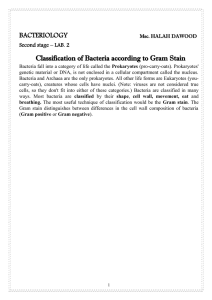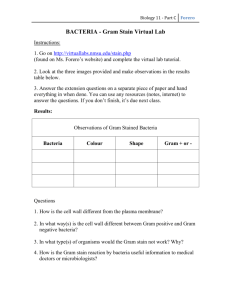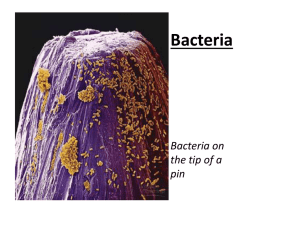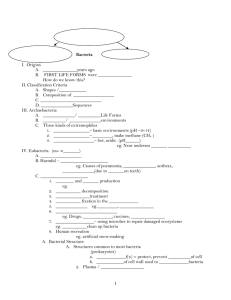Lab Quiz 1 .
advertisement
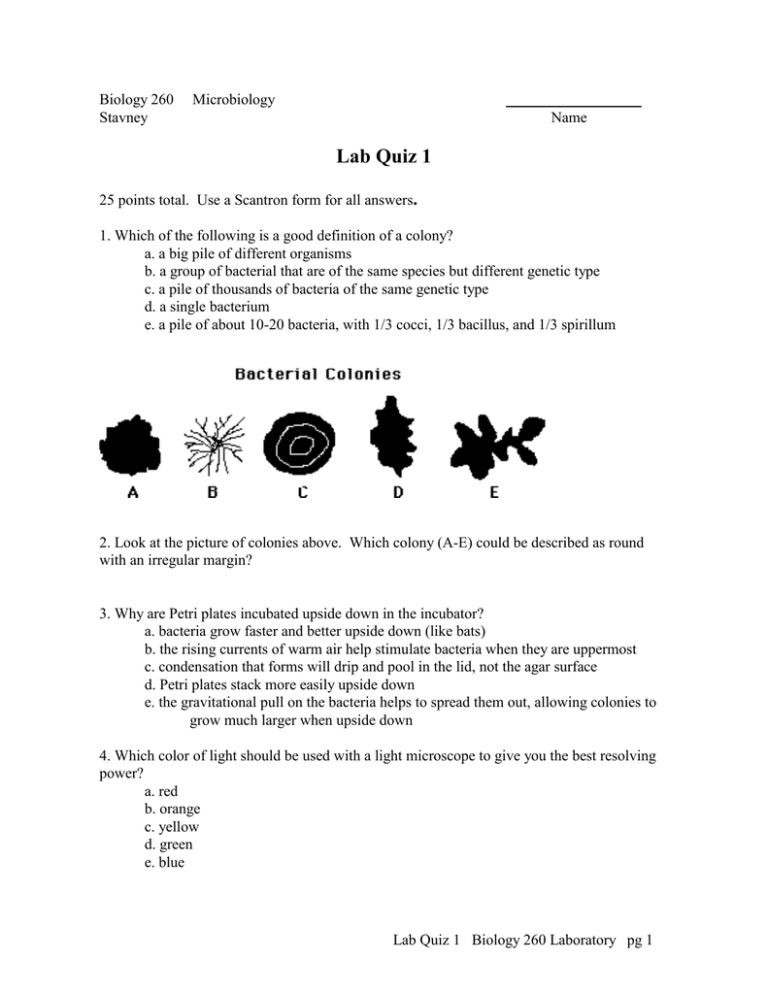
Biology 260 Stavney Microbiology Name Lab Quiz 1 25 points total. Use a Scantron form for all answers. 1. Which of the following is a good definition of a colony? a. a big pile of different organisms b. a group of bacterial that are of the same species but different genetic type c. a pile of thousands of bacteria of the same genetic type d. a single bacterium e. a pile of about 10-20 bacteria, with 1/3 cocci, 1/3 bacillus, and 1/3 spirillum 2. Look at the picture of colonies above. Which colony (A-E) could be described as round with an irregular margin? 3. Why are Petri plates incubated upside down in the incubator? a. bacteria grow faster and better upside down (like bats) b. the rising currents of warm air help stimulate bacteria when they are uppermost c. condensation that forms will drip and pool in the lid, not the agar surface d. Petri plates stack more easily upside down e. the gravitational pull on the bacteria helps to spread them out, allowing colonies to grow much larger when upside down 4. Which color of light should be used with a light microscope to give you the best resolving power? a. red b. orange c. yellow d. green e. blue Lab Quiz 1 Biology 260 Laboratory pg 1 5. What part of the microscope is used to regulate the amount of light that reaches the specimen? a. iris diaphragm b. ocular c. objective d. condenser e. mechanical stage 6. In the picture of the microscope at the right, which part points to the condenser? a. IV b. V c. VI d. X e. XII 7. In the picture of the microscope at the right, what is the name of the structure at the end of the pointer marked “I”? a. objective b. ocular c. nosepiece d. iris diaphragm e. condenser 8. The total magnification of an image viewed under OUR microscopes, using the 10X objective, is: a. 10X b. 40X c. 100X d. 400X e. 1000X 9. Assume you are preparing a direct, simple stained smear for viewing under the microscope, What is the VERY NEXT STEP that you should do assuming you have JUST air-dried the smear? a. Add the direct stain for about a minute b. Blot the smear with bibulous paper c. Put the smear slide under the microscope d. Wash the smear off with water e. Fix the smear to the slide with heat or alcohol Lab Quiz 1 Biology 260 Laboratory pg 2 10. Malachite green dye can be used to directly stain bacterial cells green in color. Malachite green therefore must be a(n): a.basic stain b.acidic stain c.neutral stain d.negative stain e. negatively charged stain 11. Why is the top part of a broth or slant culture heated in a flame immediately after removing the cap? a. to kill all the bacteria on the glass b. to stimulate the growth of bacteria in the tube c. to create warm air currents that keep other bacteria out d. to expand the glass of the test tube top so that the cap will fit more securely e. to sterilize the glass in case you touch it with your loop 12. Gram negative bacteria lose the crystal violet when ethyl alcohol is added because: a. gram negative bacteria have thicker cell walls b. alcohol dissolves the outer membrane c. crystal violet binds to gram positive DNA better than gram negative DNA d. gram positive bacteria are positively charged while gram negative bacteria are negatively charged e. ethyl alcohol oxidizes crystal violet into a lighter reddish color (like the action of bleach) 13. Which of the following bacteria is acid-fast? a. Staphylococcus epidermidis b. Moraxella catarrhalis c. Bacillus cereus d. Mycobacterium leprae e. Clostridium botulinum 14. Which of the following genera have endospore-forming bacteria? a. Staphylococcus b. Bacillus c. Moraxella d. Micrococcus e. Escherichia 15. Acid-fast bacteria are unusual because they contain: a. peptidoglycan b. mycolic acid c. lipid A d. pseudomurein e. chitin Lab Quiz 1 Biology 260 Laboratory pg 3 16. 1 pt. Name the cellular arrangement shown in the picture to the right, as seen in a sample being viewed under the electron microscope. 17. 1 pt. What is the most important safety rule in the lab? 18. 2 pts. Describe a major advantage to performing a negative stain instead of a direct (simple) stain on a bacterial culture. 14. 6 points. Fill in the blanks below to complete the grid. Gram Staining Procedure Chemical Name Function Appearance of Gram Appearance of Gram Positive Bacteria Negative Bacteria after this Step after this Step purple crystal violet mordant purple counterstain purple purple ethyl alcohol Lab Quiz 1 Biology 260 Laboratory pg 4

